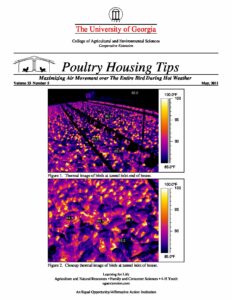In order to maximize bird cooling during hot weather it is crucial that birds remain evenly distributed throughout a house. Though the air temperature at the inlet end of a tunnel house may often be three to five degrees cooler than at the fan end, the truth is that birds at the inlet end are often the hottest birds in a house due the fact that density is often the highest near the tunnel inlet as a result of bird migration. The higher the density, the less surface area each bird has exposed ...to the cool air moving down the house, and the lower the amount of heat removed from each bird. For instance, though the birds at the inlet end of the tunnel house in Figure 1 appear to be relatively cool, the fact is that essentially only their backs and heads that are being cooled by the 81oF air entering through the house’s evaporative cooling pads. Little heat is being removed from the sides, legs, and breasts because no air is moving over these surfaces (Figures 2 and 3). Furthermore, litter temperatures are in the mid-nineties not because the litter is producing a substantial amount of heat, but rather because it is a very good insulator and there is essentially no air movement between the birds to remove the heat they are producing.
The birds at the fan end of the same house were at a much lower density and though the air temperature was a few degrees hotter, the birds were significantly cooler (Figure 4). Since a larger percentage of each bird’s body was being exposed to the 500 ft/min air speed moving down the house, more heat was being removed from each bird, resulting in cooler birds. The litter was essentially the same because their was enough air moving between the birds to prevent the build-up of bird heat.
The message is quite simple. Having 500, 600, or 700 ft/min air speed does little cooling for the birds at the inlet end of a tunnel house if they are packed tightly together. Make sure you install your migration fences as soon as possible and do whatever is needed to keep the birds evenly distributed throughout the house over the course of the flock.
Details
| Year | Volume | Number | Categories |
|---|---|---|---|
| 2011 | 23 | 5 |

